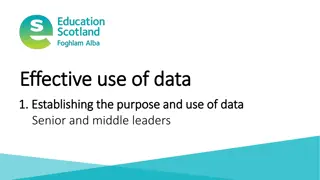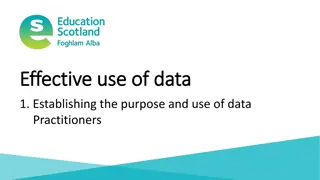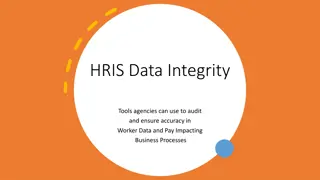
End the Era of Isolated Data. It’s Time for Integrated BI Tools That Connect More Than Points
Explore the transformative power of integrated Business Intelligence tools in this insightful blog. We delve into the challenges posed by outdated, isolated data systems and reveal how modern Business Intelligence software solutions can unify and enhance data analysis.
Download Presentation
Please find below an Image/Link to download the presentation.
The content on the website is provided AS IS for your information and personal use only. It may not be sold, licensed, or shared on other websites without obtaining consent from the author. Download presentation by click this link. If you encounter any issues during the download, it is possible that the publisher has removed the file from their server.
Presentation Transcript
End the Era of Isolated Data. Its Time for Integrated BI Tools That Connect More Than Points --------------------------------------------------------------- Have you ever felt frustrated by how long it takes to get the information you need from your business data? Do you find yourself questioning the accuracy of the data when it finally arrives? You're not the only one who can relate to these situations. According to a survey by NewVantage Partners, 85% of companies are trying to be data-driven, yet only 37% report successful results, often due to isolated data systems. And more so, only 21% of them are able to confidently use their data. Isolated data systems are like disconnected puzzle pieces. Each department may hold a piece of the puzzle, but without connecting them, the full picture remains elusive. This separation not only slows down decision-making but also affects the accuracy and reliability of the insights gained. Why continue to operate in silos when the technology exists to unify your data landscape? Integrated Business Intelligence tools are the bridge that can connect these disparate data points into a cohesive, intuitive, and actionable dashboard. These tools don t just collect data; they transform it into insights that can propel your business forward. Isn't it time to shift from juggling standalone systems to embracing a solution that integrates all your data seamlessly? In this blog, we'll explore why the shift to integrated Business Intelligence reporting tool is essential for any organization looking to thrive in today's data-driven market.
We'll uncover the limitations of outdated isolated systems and highlight the transformative benefits of modern, integrated BI solutions. Let's dive into why your business should end the era of isolated data and how integrated BI tools can connect more than just points they connect people, processes, and potential. The Limitations of Isolated Data Systems The ability to seamlessly integrate and analyze information has become increasingly critical. Yet, many organizations continue to grapple with isolated data systems. These siloed frameworks, often stemming from legacy Business Intelligence tools, pose significant challenges that can stifle a company s ability to make informed decisions swiftly and accurately. Challenges with Siloed Data Inefficiencies in Data Retrieval and Analysis: Isolated data systems typically require manual interventions to extract and consolidate data, which is not only time-consuming but also prone to errors. For example, a Business Intelligence reporting tool that cannot interact with other systems will need data to be manually formatted and imported, delaying insights and leading to potential inaccuracies. Fragmented View of the Business: When data is siloed, each department may use its own Business Intelligence tool, leading to conflicting results and interpretations. This fragmented view makes it difficult for leadership to have a clear and comprehensive understanding of business health. For instance, if the sales department s data isn t aligned with inventory, it could lead to either stockouts or overstocking, both of which have financial consequences. Impact on Business Operations Slower Decision-Making: The speed of decision-making is crucial in today's fast-paced market environments. An isolated Business Intelligence software may hinder an organization s ability to respond quickly to market changes. Without integrated insights, decisions are often based on incomplete data, reducing responsiveness and agility. Increased Costs and Resource Utilization: Maintaining multiple isolated systems can be costly. Each system might require separate support teams and infrastructure, which increases operational costs. 2
Additionally, the effort to maintain data quality and consistency across disparate systems consumes significant resources that could be better utilized elsewhere. Compliance and Security Risks: Isolated systems complicate compliance with regulations such as GDPR or HIPAA, as data tracking and auditing become cumbersome. This separation can also increase security risks, as each system may have its own set of vulnerabilities that need to be managed independently. The Advantages of Integrated BI Tools In contrast to the outdated, compartmentalized frameworks, integrated Business Intelligence tools offer a multitude of advantages that can significantly enhance business operations, agility, and decision-making capabilities. Here, we explore how these tools streamline processes and foster a more dynamic and insightful business environment. Enhanced Data Connectivity Unified Data Sources: Integrated Business Intelligence tools excel in their ability to consolidate data from diverse sources into a single, cohesive platform. Whether it's merging data from CRM systems, ERP solutions, or external databases, these tools eliminate the barriers that typically compartmentalize data across departments. For capabilities can automatically aggregate sales, marketing, and customer service data, providing a holistic view of the customer journey. instance, a Business Intelligence reporting tool with integration Simplification of Data Management: By centralizing data, integrated BI tools reduce the complexities associated with data management. Businesses can maintain a single source of truth, which simplifies data governance, enhances data quality, and reduces maintenance overhead. This centralization makes it easier for data analysts to perform their roles without the need to juggle multiple Business Intelligence software systems or reconcile conflicting data sets. Real-Time Data Analysis Immediate Insight Generation: One of the most significant benefits of using an integrated Business Intelligence tool is the ability to perform real-time data analysis. This capability allows businesses to react to market changes instantaneously, adjust strategies on the fly, and 3
preemptively address emerging issues before they escalate. For example, real-time insights generated by Business Intelligence software can help a retailer adjust pricing or promotions instantly based on live sales performance data. Enhanced Predictive Capabilities: With advanced analytics features, modern BI tools can forecast future trends based on historical data. These predictive analytics help businesses anticipate market demands, customer behaviors, and potential bottlenecks. Integrated tools enhance these capabilities by providing a more comprehensive dataset for analysis, leading to more accurate and actionable forecasts. Improved Decision-Making Data-Driven Decisions Across All Levels: Integrated Business Intelligence software democratizes data access, enabling decision-makers at all levels of an organization to leverage data-driven insights. This accessibility ensures that decisions are based on comprehensive, up-to-date information, aligning with the organization s strategic goals. For example, a manager using an integrated BI tool can quickly pull a report to analyze the impact of a recent marketing campaign on sales figures, leading to quicker and more informed decisions. Collaborative Decision-Making: When data is accessible and interpretable across departments, it fosters a collaborative environment where insights are shared and strategies are developed cohesively. Integrated BI tools often come equipped with collaboration features that allow team members to share dashboards, annotate reports, and make collective decisions based on unified data views. Key Features of Modern Integrated BI Tools Modern integrated Business Intelligence tools are equipped with a variety of sophisticated features that not only enhance the efficiency of data processing but also revolutionize the way businesses interpret and utilize their data. Here, we delve into the key features that set a Business Intelligence reporting tool apart, focusing on its benefits and practical applications in a business context. Data Integration Capabilities Comprehensive Data Connectivity: A standout feature of contemporary Business Intelligence software is its robust data integration capabilities. These tools can seamlessly connect with various data sources, including cloud storage, on-premise databases, and third-party applications. This integration allows businesses to pull data from multiple sources into a 4
centralized platform, ensuring that all insights are derived from a complete data set. For example, a Business Intelligence tool can integrate data from marketing platforms, sales databases, and customer feedback tools to provide a unified view of customer engagement. Automated Data Synchronization: To maintain the accuracy and relevance of data, modern BI tools automatically synchronize data across systems. This feature ensures that the data displayed on dashboards and in reports is always current, which is critical for making timely decisions. Automatic updates eliminate the need for manual data entry, reducing the risk of errors and freeing up valuable resources for more strategic tasks. Advanced Analytics Predictive Analytics and Machine Learning: Advanced analytics is a core component of modern Business Intelligence reporting tools. These systems utilize machine learning algorithms to analyze historical data and predict future trends. Businesses can use these predictions to optimize operations, forecast sales, and better understand customer behavior. For instance, a BI tool might predict customer churn, allowing proactive engagement strategies to be implemented to retain clients. Natural Language Processing (NLP): Some of the latest BI tools incorporate NLP, enabling users to generate queries and receive insights in natural language. This feature makes data analytics accessible to non-technical users, as they can simply ask questions like "What were our sales last quarter?" and receive an immediate response. This accessibility broadens the base of BI users within an organization, empowering more employees to leverage data in their decision-making processes. User-Friendly Dashboards Customizable and Interactive Dashboards: Customization is a key feature of modern Business Intelligence tools, allowing users to tailor dashboards to their specific needs. These interactive dashboards can display a variety of data visualizations, such as graphs, heat maps, and pivot tables, which help in interpreting complex datasets at a glance. Users can interact with these visualizations, drilling down into the data for more detailed analysis, which is crucial for uncovering deeper insights. Real-Time Reporting: 5
Integrated BI tools offer the capability of real-time reporting, which is essential for dynamic and fast-paced business environments. This feature ensures that decision-makers have access to the most up-to-date information, enabling immediate responses to emerging trends or issues. Real-time reporting can significantly enhance operational responsiveness and strategic planning. Conclusion The transition from isolated data systems to integrated Business Intelligence tools marks a crucial evolution in the landscape of data management. As we have discussed, the limitations of isolated systems are significant, impeding the speed and accuracy of business decision-making, and increasing operational costs and security risks. On the other hand, the advantages of integrated BI tools bring a wealth of benefits improved data connectivity, decision-making capabilities that span all levels of an organization. real-time analysis, and enhanced Integrated BI tools like Grow are not just about connecting data points; they are about connecting people, processes, and insights in a manner that is transformative. Grow's Business Intelligence software allows for seamless integration, real-time data analysis, and user-friendly, customizable dashboards that empower users to harness the full potential of their data without the need for extensive technical expertise. Why Choose Grow? Unified Data Management: Grow's BI tools simplify the complexity of data systems, allowing for streamlined operations and better governance. Real-Time Insights: With Grow, your data is not just current it's actionable, providing the ability to make decisions at the pace of business. Accessible Analytics for All: Grow democratizes data analysis, making it accessible to users at all levels within an organization, enhancing collective decision-making and strategic alignments. As we conclude this discussion, it's clear that the era of isolated data is behind us. Now is the time to embrace integrated BI tools that offer not just data integration but a comprehensive platform for strategic business transformation. Take Action Now: Explore what Grow can do for your business by signing up for a 14-day free trial. Experience firsthand how integrated insights can change the way you operate. Learn from other businesses like yours by checking out Grow.com Reviews & Product Details on G2. See why many are turning to Grow for their BI needs. 6
With Grow, bridge the gap between data and decision-making, and transform the way you view business intelligence forever. 7
















































